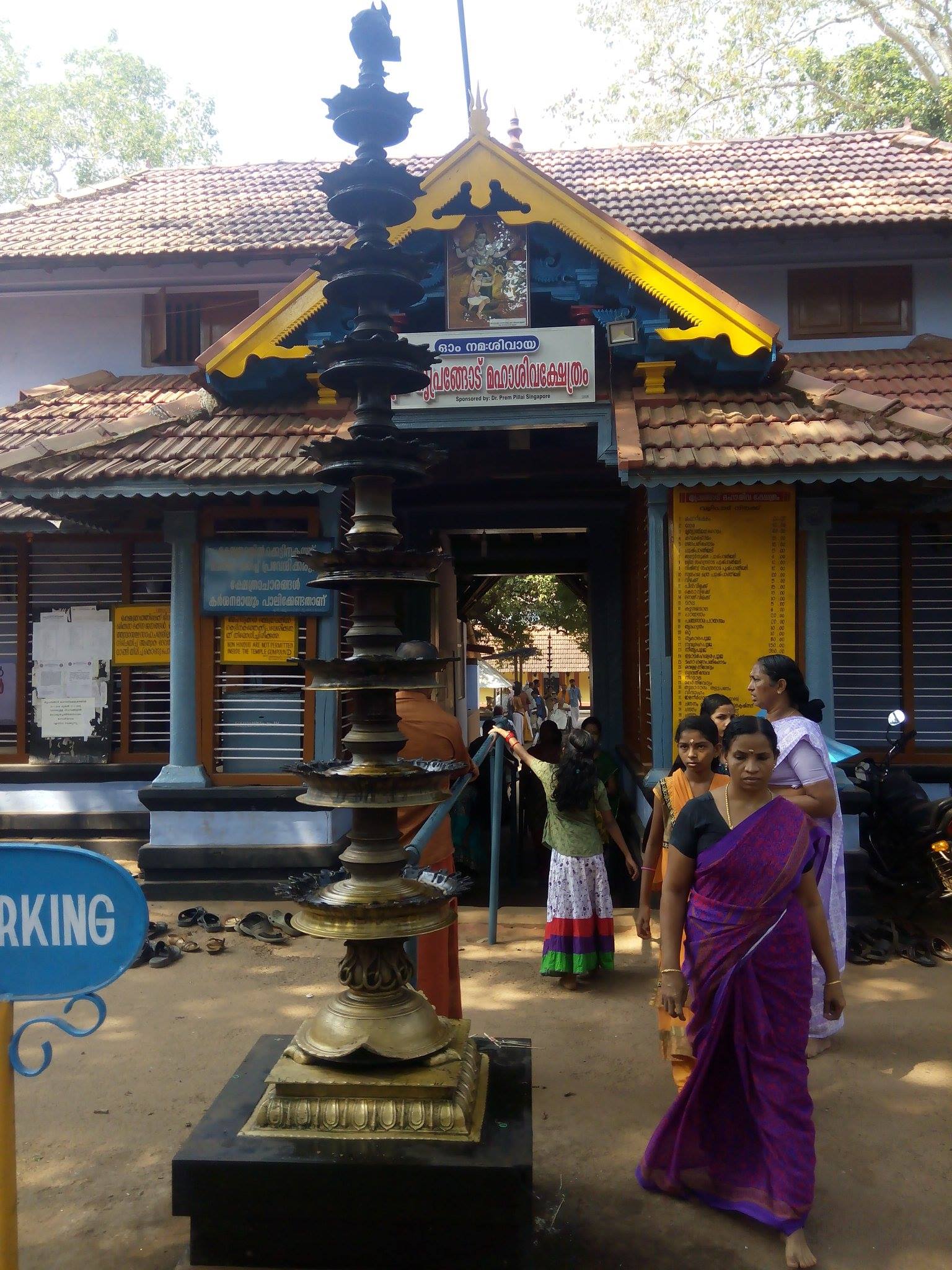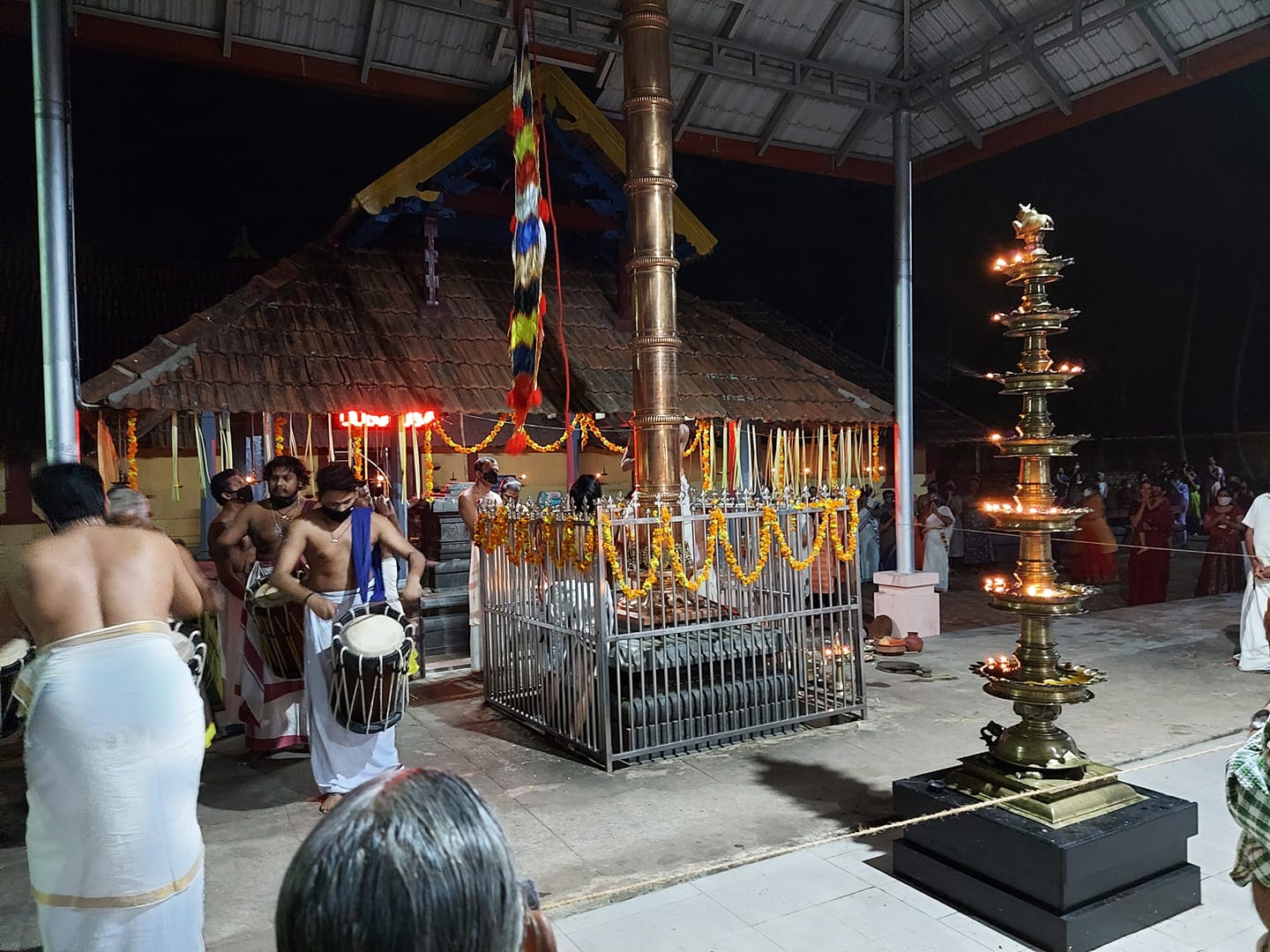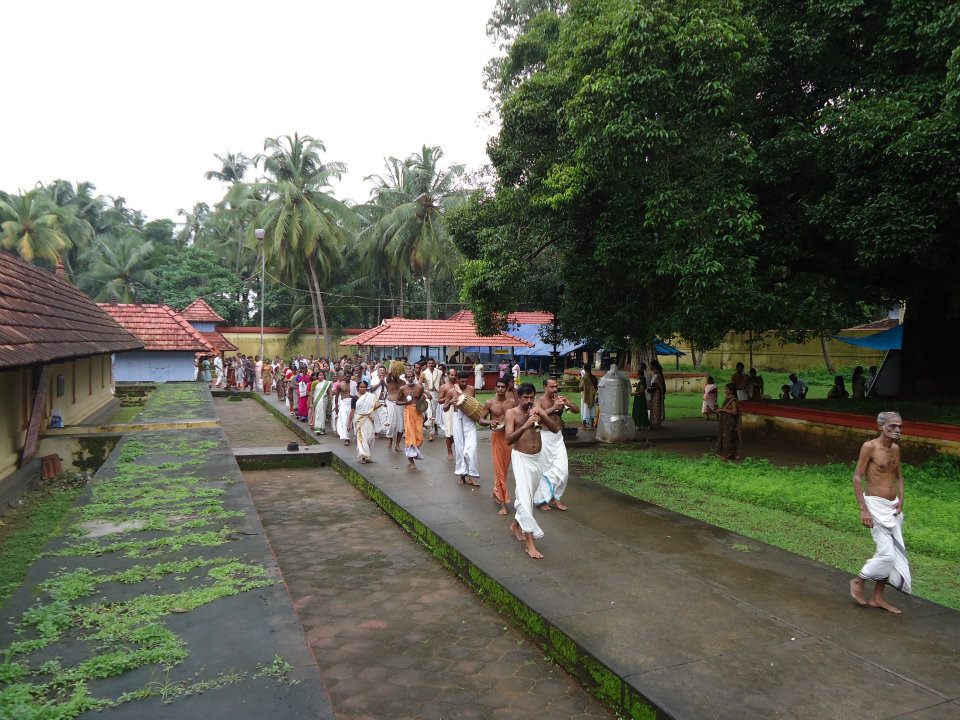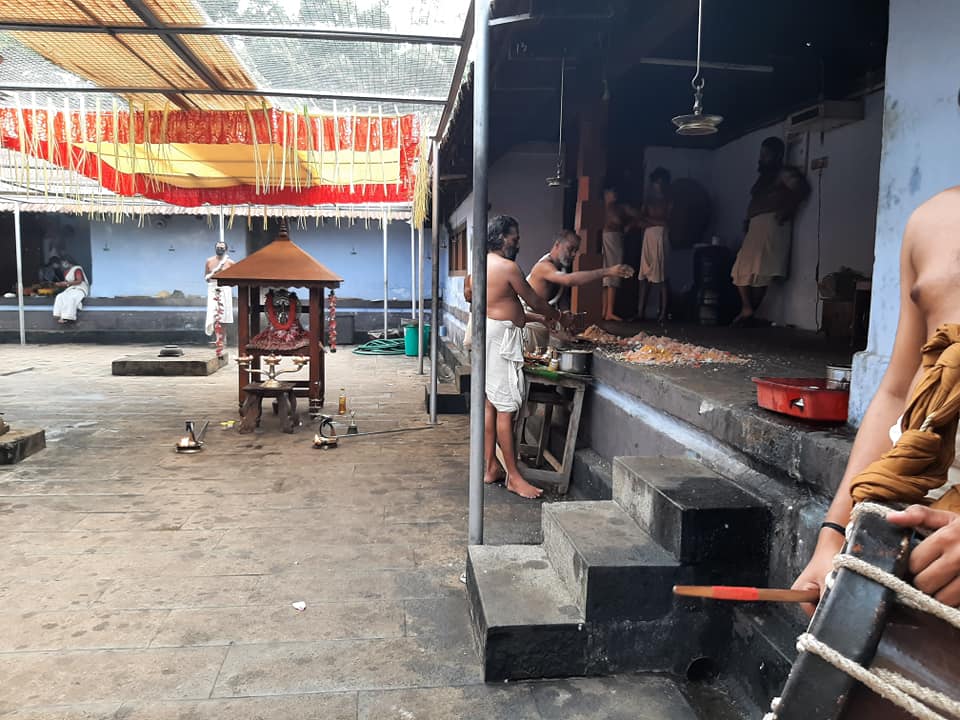Triprangode Siva Temple is a prominent Hindu temple located in Triprangode, near Tirur in the Malappuram district of Kerala.
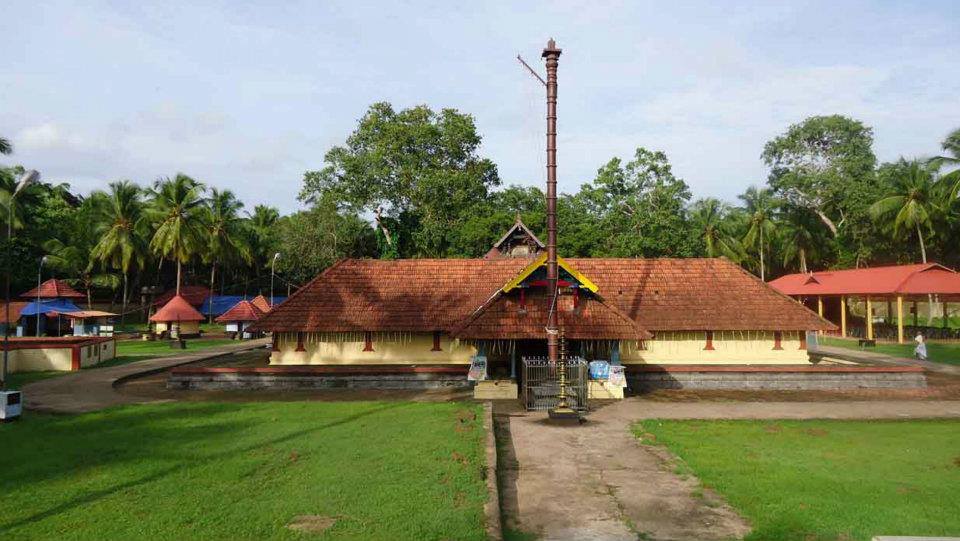
This ancient temple lies about 5 kilometers west of the Tirunavaya railway station and 10 kilometers south of the Tirur railway station, making it one of the key pilgrimage centers in northern Kerala. The 15th-century literary work Kokila Sandeśa by Uddanta Sanstrikal mentions Triprangode among the major destinations in the region. Inscriptions from the reign of the Later Chera ruler Goda Ravi Varma (10th century) have been discovered at the temple. Historically, the area became part of the Kingdom of Tanur (Vettathunad), vassals of the Zamorins of Calicut. During the 14th-century Thirunavaya Wars, the main army of the Zamorin was stationed at Triprangode.
Long ago, there lived a sage named Mrikandu and his wife Marudvati, both ardent devotees of Lord Shiva—the Eternal Lord, Mahakaleshvara, the Originator and Destroyer of Time, also known as Kalasamhara Murti. The couple had no children, so they performed intense austerities seeking Shiva's blessings for a child. Pleased by their devotion, Shiva appeared before them and offered a choice: either a mentally disabled son with a long life, or an exceptionally gifted son with a short lifespan of just sixteen years. The couple chose the latter.
In time, Marudvati gave birth to a brilliant child named Markandeya. From a young age, Markandeya showed extraordinary wisdom and devotion to Shiva, and mastered the powerful Mahamrityunjaya Mantra. As he neared his sixteenth birthday, his parents grew increasingly sorrowful. Upon learning the reason, Markandeya turned to Lord Vishnu for help, but Vishnu directed him to Triprangode Temple, dedicated to Lord Shiva.
On his way there, a massive banyan tree blocked his path. Miraculously, the tree split apart to let him through. Reaching the temple, Markandeya embraced the Shiva Lingam and pleaded for protection. Just then, Yama, the god of death, cast his noose around the boy-sage—and it also encircled the Shiva Lingam.
Enraged by this act, the Shiva Lingam split open with a thunderous roar, and Lord Shiva emerged in a blazing, fierce form. He condemned Yama for daring to lasso the sacred Lingam and struck him down with his trident. Yama was killed, and Markandeya was saved from death. Shiva then blessed Markandeya with eternal youth, decreeing that he would remain forever as a sixteen-year-old sage.
Devas, witnessing the event, implored Shiva to revive Yama to prevent chaos in the world where no one would die. Shiva agreed and brought Yama back to life, declaring that His true devotees would be spared from Yama’s noose. Since that day, the fiery form in which Shiva appeared is revered as Kalasamhara Murti, the Destroyer of Time and Death.
The Triprangode Siva Temple in Malappuram is surrounded by five significant ponds, three of which lie within the temple complex itself, each holding religious and cultural importance. The pond in front of the Karanayil Temple is believed to be the original seat of the deity, affirming the sanctity of that spot. Nearby are two more ponds: Santhikkulam, where priests bathe for purification before rituals, and Vellottukulam, named after the adjacent Vellottu fields. At the south-western corner lies a sacred pond where Lord Shiva is believed to have washed his trident after slaying Yama to protect his devotee Markandeya. Outside the complex, on the north-eastern side, a large pond serves the public for activities like swimming and washing cattle, and is also used by devotees for ritual cleansing before entering the temple.
An interesting architectural feature of the Triprangode Siva Temple is the presence of all three traditional types of sreekovils (sanctum sanctorum) found in Kerala. The main shrine is a large, two-storied structure in the Gajaprishta style, resembling the back of an elephant, with a southern extension housing Goddess Parvati, symbolizing the Ardhanarishwara concept. In front of it lies the namaskara mandapam, used by Brahmins for chanting Vedas and the Shiva Sahasranama, and nearby stands the idol of Nandi, along with an idol of Lord Ganesha on the south-western door facing east. To the north of the main shrine are four sub-shrines of Lord Shiva and a shrine for Lord Vishnu, whose idol appears in his classic four-armed form bearing the Shankha, Chakra, Gada, and Lotus. The original sanctum, Karanayil Temple, is a two-storied square structure, while the shrine marking the Lord’s first step is round, and the other two are square. Behind the Karanayil Temple are shrines for Lord Vettakkorumakan and Goddess Bhadrakali, all west-facing. On the southern side, the shrine of Lord Ayyappa also faces west, and nearby stands a stone idol of Lord Shiva as Mrityunjaya (the Conqueror of Death), slightly damaged during Tipu Sultan’s invasion, serving as the anthropomorphic representation of the main deity. In the south-western section, there are shrines for Lord Krishna as Gosalakrishna (cowherd form), Snake deities, and Brahmarakshas, all facing east, with Krishna’s shrine uniquely designed to resemble a cowshed.
തൃപ്രങ്ങോട് മഹാദേവ ക്ഷേത്രം
കേരളത്തിലെ പ്രസിദ്ധശിവക്ഷേത്രങ്ങളിൽ ഒന്നായ തൃപ്രങ്ങോട് ശിവക്ഷേത്രം മലപ്പുറം ജില്ലയിലെ തിരൂർ താലൂക്കിൽ സ്ഥിതിചെയ്യുന്ന തൃപ്രങ്ങോട് ഗ്രാമത്തിലാണ് സ്ഥിതി ചെയ്യുന്നത്. പുരാണകഥകളുമായി ബന്ധപ്പെട്ട ഈ ക്ഷേത്രം, ഭാരതഭൂമിയിൽ പരശുരാമൻ സ്ഥാപിച്ചുവെന്ന് വിശ്വസിക്കപ്പെടുന്ന 108 ശിവക്ഷേത്രങ്ങളിൽ ഒന്നാണ്. ഇവിടെ ഉള്ള ശിവപ്രതിഷ്ഠ കാലസംഹാരമൂർത്തിസങ്കൽപത്തിലാണ്, പടിഞ്ഞാറോട്ടുള്ള ദർശനത്തോടുകൂടി. ഇതിനു പുറമേ, ഈ ക്ഷേത്രത്തിൽ കൂടാതെ നാലു ശിവപ്രതിഷ്ഠകളും നിലകൊള്ളുന്നു. പാർവ്വതി, ഗണപതി, ദക്ഷിണാമൂർത്തി, മഹാവിഷ്ണു, ശ്രീകൃഷ്ണൻ, അയ്യപ്പൻ, വേട്ടക്കൊരുമകൻ, ഭദ്രകാളി, ബ്രഹ്മരക്ഷസ്സ് എന്നിവർക്കും ഉപദേവതാരൂപത്തിൽ പ്രതിഷ്ഠകളുണ്ട്. ധനുമാസത്തിലെ തിരുവാതിര ആറാട്ടോടുകൂടിയ എട്ടുദിവസത്തെ ഉത്സവവും കുംഭമാസത്തിലെ മഹാശിവരാത്രിയും ഈ ക്ഷേത്രത്തിലെ പ്രധാന ഉത്സവങ്ങളാണ്. ഈ ക്ഷേത്രം കോഴിക്കോട് സാമൂതിരി രാജാവിന്റെ ഉടമസ്ഥതയിലുള്ളതുമാണ്.
പതിനെട്ട് പുരാണങ്ങളിൽ സുപ്രധാനമായ മാർക്കണ്ഡേയപുരാണത്തിൽ നിന്നാണ് തൃപ്രങ്ങോട് ശിവക്ഷേത്രത്തിന്റെ ഉദ്ഭവത്തിന് ആധാരം ഉള്ളത്. കഥയുടെ അടിസ്ഥാനത്തിൽ, പ്രാചീനകാലത്ത്, ക്ഷേത്രത്തിന്റെ വടക്കുകിഴക്കേമൂലത്ത് ആദ്യം നിർമ്മിതമായിരുന്നാണ്. അന്നത്തെ ദിവസങ്ങളിൽ, താപസശ്രേഷ്ഠനായ മൃഗണ്ഡു മഹർഷിയുടെയും അദ്ദേഹം പരിയമായ മദ്രുവതിയുടെയും വിവാഹം കഴിഞ്ഞ്, ദീർഘകാലം കഴിഞ്ഞിട്ടും ഇവർക്ക് സന്താനസൗഭാഗ്യം ലഭിച്ചിരുന്നില്ല. ഇതിൽ ദു:ഖിതരായ അവർ ശിവനെ ഭജിച്ച് തപസ്സു ചെയ്തു. വലിയ കഠിനതപസ്സിനൊടുവിൽ ഭഗവാൻ ശിവൻ പ്രത്യക്ഷപ്പെട്ട് അവരോട് ചോദിച്ചപ്പോൾ: "നൂറുവയസ്സുവരെ ജീവിക്കുന്ന മകനാണോ വേണ്ടത്, അല്ലെങ്കിൽ പതിനാറുവയസ്സുവരെ ജീവിക്കുന്ന എല്ലാം തികഞ്ഞ മകനാണോ?" എന്നുള്ളത്. ഈ ചോദ്യം ഇരുവരെയും വിഷമിപ്പിച്ചു, എങ്കിലും അവർ തിരിച്ചറിയുകയും ചെയ്തു, "ദീർഘായുസ്സ് തന്നെമികച്ചത് അല്ലെങ്കിൽ അല്പായുസ്സ് മുഴുവൻ ദൈവം അനുഗ്രഹിച്ചാൽ, അത് തന്നെ മികച്ചതാണ്," എന്ന്. അതിനാൽ അവർ പതിനാറു വയസ്സിൽ ജീവിക്കുന്ന മകനെയാണ് ആവശ്യപ്പെടുന്നത്.
പിന്നീട് അവർക്ക് ജനിച്ച മകനാണ് മാർക്കണ്ഡേയൻ. ചെറുപ്പത്തിൽ തന്നെ മാർക്കണ്ഡേയൻ വേദശാസ്ത്രം എന്നിവയിൽ വിദഗ്ധനായി. കാലം കടന്നപ്പോൾ, മാർക്കണ്ഡേയന്റെ പതിനാറാം പിറന്നാളിൽ, കാലൻ (മരണം) അവന്റെ ആയുസ്സിന്റെ അവസാനത്തെ സമയം തിരിച്ചറിഞ്ഞു. ഈ സമയത്ത് മാർക്കണ്ഡേയൻ തിരുനാവായ ക്ഷേത്രത്തിൽ ദർശനം നടത്തുകയായിരുന്നു. പെട്ടെന്ന് കാലൻ തന്റെ പിന്നാലെ വരുന്നത് കണ്ടു. ഇത് കണ്ട മാർക്കണ്ഡേയൻ ഭയത്തോടും പെട്ടെന്നുള്ളതിനാൽ ശ്രീലകത്തിൽ കടന്നു നാവാമുകുന്ദനെ ശരണം പ്രാപിച്ചു. ഭഗവാൻ അവനോട് ഇങ്ങനെ പറഞ്ഞു:
"ഹേ മാർക്കണ്ഡേയാ, കാലനുമായി ഏറ്റുമുട്ടാൻ സാക്ഷാൽ മഹാദേവനു മാത്രമേ സാധിക്കൂ. അതിനാൽ, നീ മഹാദേവനെ ശരണം പ്രാപിക്കുക. നിനക്ക് ഒരു വഴിയുണ്ട്: പടിഞ്ഞാറ് നടയിലൂടെ അടുത്തുള്ള തൃപ്രങ്ങോട്ട് ക്ഷേത്രത്തിൽ പോവുക. ഞാൻ നിനക്ക് കുറച്ച് കല്ലുകൾ തരാം.
കാലൻ അടുത്തെത്തുന്നതായി തോന്നിയാൽ, ഉടനെ അവയെ എടുത്ത് പിൻവലിയുക. അങ്ങനെ പോയാൽ, നീ കാലനിൽ നിന്ന് രക്ഷപ്പെടും."
ശിവനു നിന്നുള്ള ഈ ഉപദേശം സ്വീകരിച്ച്, ഭഗവാൻ മാർക്കണ്ഡേയന് പന്ത്രണ്ട് കല്ലുകൾ നൽകി. ശേഷം, പുറത്ത് കാലനെ കാണുന്നതോടെ ഭഗവാൻ തന്റെ ശ്രീലകത്തിന്റെ പുറകുവശത്ത് (പടിഞ്ഞാറ്) ഒരു വാതിലുണ്ടാക്കി. മാർക്കണ്ഡേയൻ അവിടെ നിന്നും ഇറങ്ങി ഓടി, പിന്നീട് വാതിൽ അടച്ചു. ഇന്നും ഈ വാതിൽ തിരുനാവായ ക്ഷേത്രത്തിൽ കാണാവുന്നതാണ്. പ്രതീകാത്മകമായും, നന്ദികേശന്റെ ഒരു വിഗ്രഹം അവിടെ സ്മാരകമായി സ്ഥാപിച്ചിട്ടുണ്ട്.
നാവാമുകുന്ദന്റെ ഉപദേശാനുസരിച്ച്, മാർക്കണ്ഡ്േയൻ കാലൻ അടുത്തെത്തിയപ്പോൾ കല്ലുകൾ എറിയുകയായിരുന്നു.
എന്നാൽ, പന്ത്രണ്ട് കല്ലുകൾ തൃപ്രങ്ങോട്ട് ക്ഷേത്രത്തിലെത്താൻ മുമ്പ് തീരുകയായിരുന്നു. അവസാനമായി, മാർക്കണ്ഡേയൻ ക്ഷേത്രനടയിൽ എത്തി. അവിടെ ഒരു വലിയ പേരാൽമരം പാത തുന്നിയിരുന്നു. മാർക്കണ്ഡേയൻ പത്രം നടുകെ പിളർത്ത്, ശ്രീകോവിലിലേക്ക് നടന്നു. പദവിയിലേൽ, അദ്ദേഹം ശിവലിംഗത്തെ കെട്ടിപ്പിടിച്ചു. ഇതു കണ്ട ദേഷ്യകൂടിയ കാലൻ അദ്ദേഹത്തേയും ശിവലിംഗത്തെയും ആക്രമിച്ചു. എന്നാൽ, ശിവലിംഗത്തിൽ നിന്നും പരമശിവൻ പ്രത്യക്ഷപ്പെട്ട് വലിയൊരു ഏറ്റുമുട്ടലിനുശേഷം, തന്റെ ശൂലം കൊണ്ട് കാലനെ കുത്തി കൊന്നു.പിന്നീട്, തന്റെ ശ്രീകോവിൽ നിന്നും മൂന്നടി തെക്കുപടിഞ്ഞാറായി പോയി, അടുത്തുള്ള കുളത്തിൽ ശൂലം കഴുകി, ഇന്നത്തെ പ്രധാന ശ്രീകോവിൽ സ്ഥിതിചെയ്യുന്ന സ്ഥലത്ത് സ്വയംഭൂവായി അവതരിച്ചു.
നിത്യേന അഞ്ചുപൂജകളും മൂന്നുശീവേലികളുമുള്ള മഹാക്ഷേത്രമായ തൃപ്രങ്ങോട് മഹാശിവക്ഷേത്രം ദിവസേന പല ചടങ്ങുകൾക്കൊപ്പം പ്രാർത്ഥനയും ആരാധനയും നടത്തുന്നു. രാവിലെ അഞ്ചുമണിയോടെ നടതുറക്കുന്നതാണ് ആരംഭം. ആദ്യം നിർമ്മാല്യദർശനമുണ്ടാകും, തുടർന്ന് അഭിഷേകമാണ്. അഭിഷേകത്തിനുശേഷം, മലർ നിവേദ്യം നടക്കും, പിന്നീട് നടയടച്ച് ഉഷഃപൂജ നടത്തപ്പെടും. ആറു മണിക്ക് എതൃത്പൂജയും ഗണപതിഹോമവും തുടർന്ന് ശീവേലിയും നടത്തപ്പെടുന്നു.
ശീവേലി കഴിഞ്ഞ ശേഷം നവകാഭിഷേകവും ശംഖാഭിഷേകവും ധാരയും നടക്കും. പതിനൊന്നുമണിയോടെ ഉച്ചപ്പൂജയും പതിനൊന്നരയോടെ ഉച്ചശീവേലിയും നടത്തപ്പെടും. പന്ത്രണ്ടുമണിയോടെ നടയടയ്ക്കുന്നു.
വൈകീട്ട് അഞ്ചുമണിയ്ക്ക് വീണ്ടും നടതുറക്കുന്നു. സന്ധ്യാകാലത്ത്, സൂര്യാസ്തമയാനുസരിച്ച് ദീപാരാധനയും, ശേഷം ഏഴു മണിക്ക് അത്താഴപ്പൂജയും ഏഴരയോടെ അത്താഴശീവേലിയും നടക്കുന്നു. പിന്നീട്, തൃപ്പയും നടത്തി എട്ടുമണിയ്ക്ക് വീണ്ടും നടയടയ്ക്കുന്നു. തൃപ്രങ്ങോട് ക്ഷേത്രത്തിലെ പ്രധാന വഴിപാട് ശംഖാഭിഷേകമാണ്, ഇത് ഒരു അപൂർവമായ ആചാരമാണ്. ക്ഷേത്രക്കുളത്തിൽ നിന്നെടുക്കുന്ന ജലം, വലംപിരി ശംഖിൽ നിറച്ച്, മന്ത്രപുരഃസരം അഭിഷേകം ചെയ്യുന്നതാണ് ഈ ചടങ്ങിന്റെ പ്രഥമമായ രീതിയ്. ഈ ശംഖാഭിഷേകം, പ്രധാനമായും പന്തീരടിപൂജയോടനുബന്ധിച്ചാണ് നടക്കുന്നത്.
ക്ഷേത്രത്തിലെ പ്രധാന യാതനകൾ, അതായത്, കൽപ്പുഴ കുടുംബം, തന്ത്രിമാരായ വടക്കേടത്ത്, തെക്കേടത്ത് കൽപ്പുഴ മനക്കാർ, ഈ ഉപാസനകളെ നടത്തുന്നതിന് ബാധ്യത വഹിക്കുന്നു.
ശംഖാഭിഷേകത്തിന്റെ തുടക്കം സംബന്ധിച്ച് ഒരു ഐതിഹ്യവും നിലവിലുണ്ട്. കാലസംഹാരത്തിനുശേഷം, മൃത്യുഞ്ജയഭഗവാൻ വൃദ്ധവേഷത്തിൽ വന്ന്, തെക്കുപടിഞ്ഞാറേമൂലയിലെ കുളത്തിൽ നിന്ന് വെള്ളം എടുത്ത് തന്റെ തലയിൽ ഒഴിച്ചുകൊണ്ടിരുന്നു. ഇതിന്റെ തെളിവായി, ഒരു ബാലൻ അത് കാണുകയും തന്റെ സഹായം ആവശ്യപ്പെടുകയും ചെയ്തു.
ഭഗവാൻ, അവനെ സഹായിക്കാൻ ആഹ്വാനം ചെയ്തെങ്കിലും, ഇതിന്റെ പൂജാവിധികളെക്കുറിച്ച് നിർദ്ദേശങ്ങൾ നൽകി, പിന്നീട് അപ്രത്യക്ഷനായി. ഇതോടെയാണ് തൃപ്രങ്ങോടപ്പന്റെ ശംഖാഭിഷേകം ആരംഭിക്കുന്നത്.
പന്തീരടിപൂജ കഴിഞ്ഞ്, ക്ഷേത്രത്തിൽ രാവിലെ എട്ടുമണിയ്ക്ക് ആരംഭിക്കുന്ന ഈ അഭിഷേകം, ഉച്ചപ്പൂജ വരെ തുടരും. ഭക്തർ വിശ്വസിക്കുന്നു, ഈ ശംഖാഭിഷേകം നടത്തിയാൽ, സർവ്വാഭിഷ്ടങ്ങൾ സാധിക്കും.
ധനുമാസത്തിൽ, തിരുവാതിരയുടെ സമയത്ത്, തൃപ്രങ്ങോട് ക്ഷേത്രത്തിൽ നടക്കുന്ന കൊടിയേറ്റുത്സവം എട്ടുദിവസമാണ് നീണ്ടുനിൽക്കുന്നത്. ശിവരാത്രിയോടനുബന്ധിച്ചുണ്ടായിരുന്ന പഴയ ഉത്സവം, 2009-ൽ ഉണ്ടായ ദേവപ്രശ്നത്തിനുശേഷം തിരുവാതിരയോടനുബന്ധിച്ചാണ് ആഘോഷം തുടങ്ങിയത്. ധ്വജാദിമുറയിലൂടെ, അതായത് കൊടിയേറ്റത്തോടെ ആരംഭിക്കുന്ന ഈ ഉത്സവത്തിൽ, നിരവധി വിശേഷാ പൂജകളും ചടങ്ങുകളും നടത്തുന്നുണ്ട്.ഉദയാസ്തമയ പൂജ, പ്രദോഷ പൂജ, ഉമാമഹേശ്വരപൂജ, സ്വയംവര പുഷ്പാഞ്ജലി, മൃത്യുഞ്ജയ ഹോമം, മൃത്യുഞ്ജയ അർച്ചന, ആയുർസൂക്ത പുഷ്പാഞ്ജലി, രുദ്രസൂക്ത പുഷ്പാഞ്ജലി, കൂവളഹാര സമർപ്പണം തുടങ്ങിയ പ്രധാന വഴിപാടുകൾ തൃപ്രങ്ങോട് മഹാശിവക്ഷേത്രത്തിന്റെ പ്രതി ദിവസത്തെ ചടങ്ങുകളിൽ ഉൾപ്പെടുന്നു.
